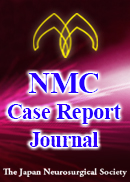Volume 2, Issue 3
Displaying 1-10 of 10 articles from this issue
- |<
- <
- 1
- >
- >|
Case Reports
-
2014Volume 2Issue 3 Pages 85-87
Published: 2014
Released on J-STAGE: July 01, 2015
Advance online publication: February 20, 2015Download PDF (2088K) Full view HTML -
2014Volume 2Issue 3 Pages 88-92
Published: 2014
Released on J-STAGE: July 01, 2015
Advance online publication: June 26, 2015Download PDF (2686K) Full view HTML -
2014Volume 2Issue 3 Pages 93-96
Published: 2014
Released on J-STAGE: July 01, 2015
Advance online publication: June 26, 2015Download PDF (4670K) Full view HTML -
2014Volume 2Issue 3 Pages 97-100
Published: 2014
Released on J-STAGE: July 01, 2015
Advance online publication: June 26, 2015Download PDF (2039K) Full view HTML -
2014Volume 2Issue 3 Pages 101-105
Published: 2014
Released on J-STAGE: July 01, 2015
Advance online publication: June 26, 2015Download PDF (2358K) Full view HTML -
2014Volume 2Issue 3 Pages 106-108
Published: 2014
Released on J-STAGE: July 01, 2015
Advance online publication: June 26, 2015Download PDF (1990K) Full view HTML -
2014Volume 2Issue 3 Pages 109-113
Published: 2014
Released on J-STAGE: July 01, 2015
Advance online publication: June 26, 2015Download PDF (2933K) Full view HTML -
2014Volume 2Issue 3 Pages 114-117
Published: 2014
Released on J-STAGE: July 01, 2015
Advance online publication: June 26, 2015Download PDF (1848K) Full view HTML -
2014Volume 2Issue 3 Pages 118-122
Published: 2014
Released on J-STAGE: July 01, 2015
Advance online publication: June 26, 2015Download PDF (1638K) Full view HTML
Editorial Committee
-
2015Volume 2Issue 3 Pages EC5-EC6
Published: 2015
Released on J-STAGE: July 01, 2015
Download PDF (858K)
- |<
- <
- 1
- >
- >|
